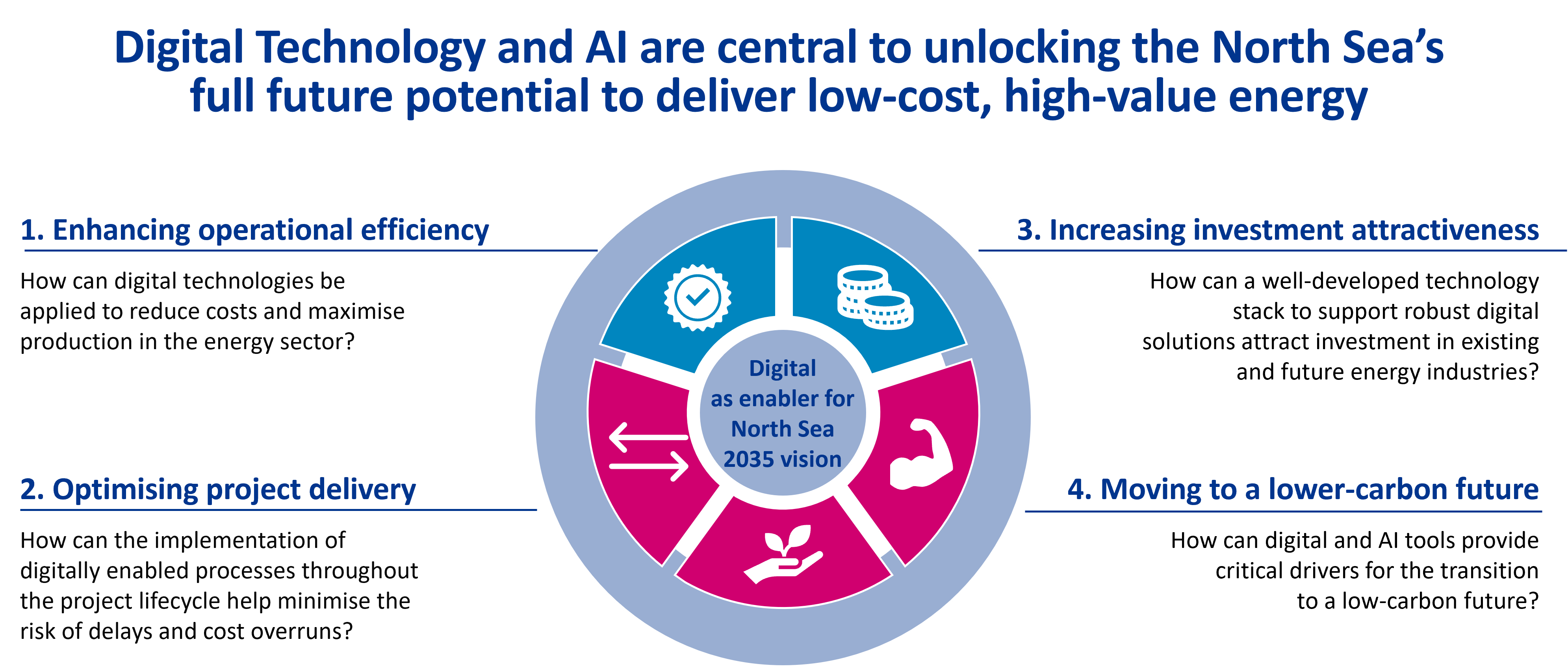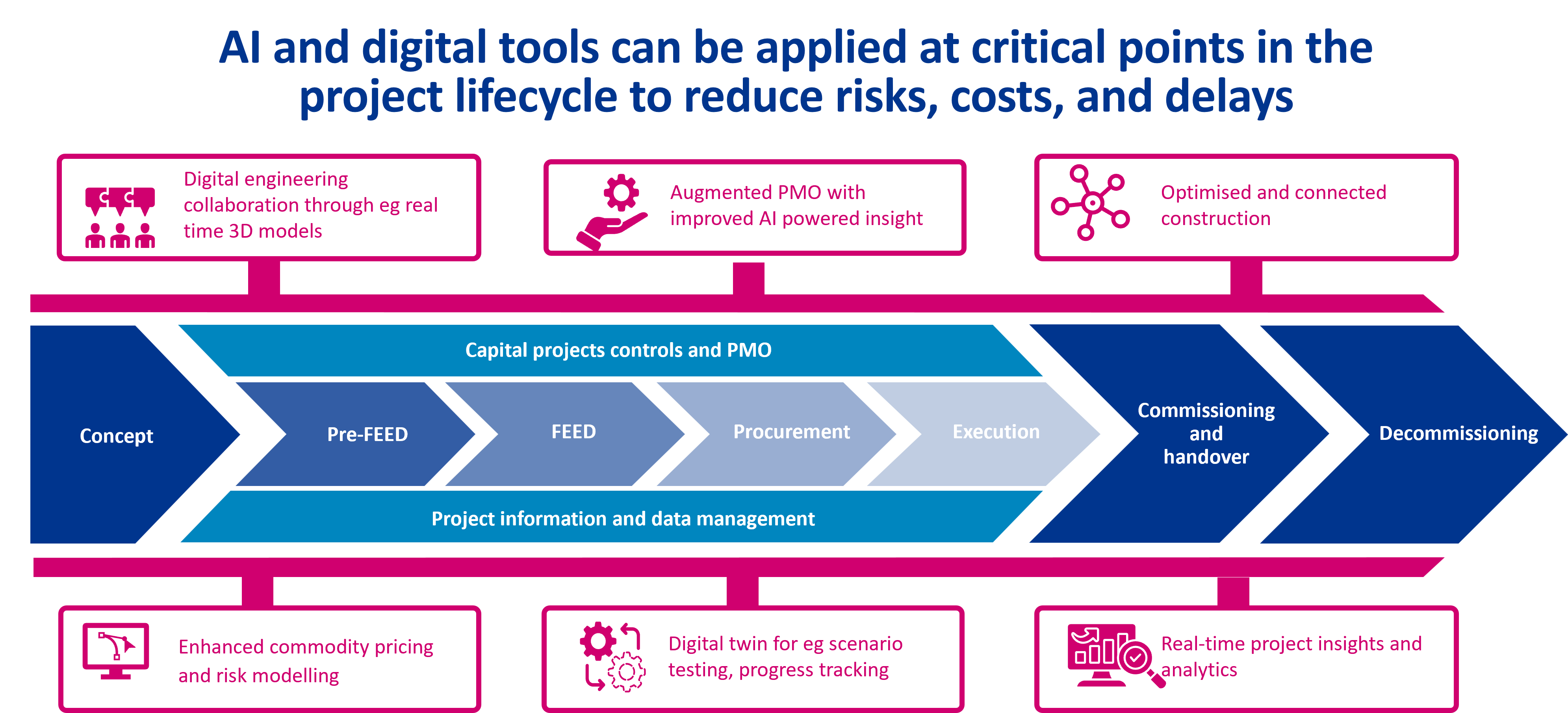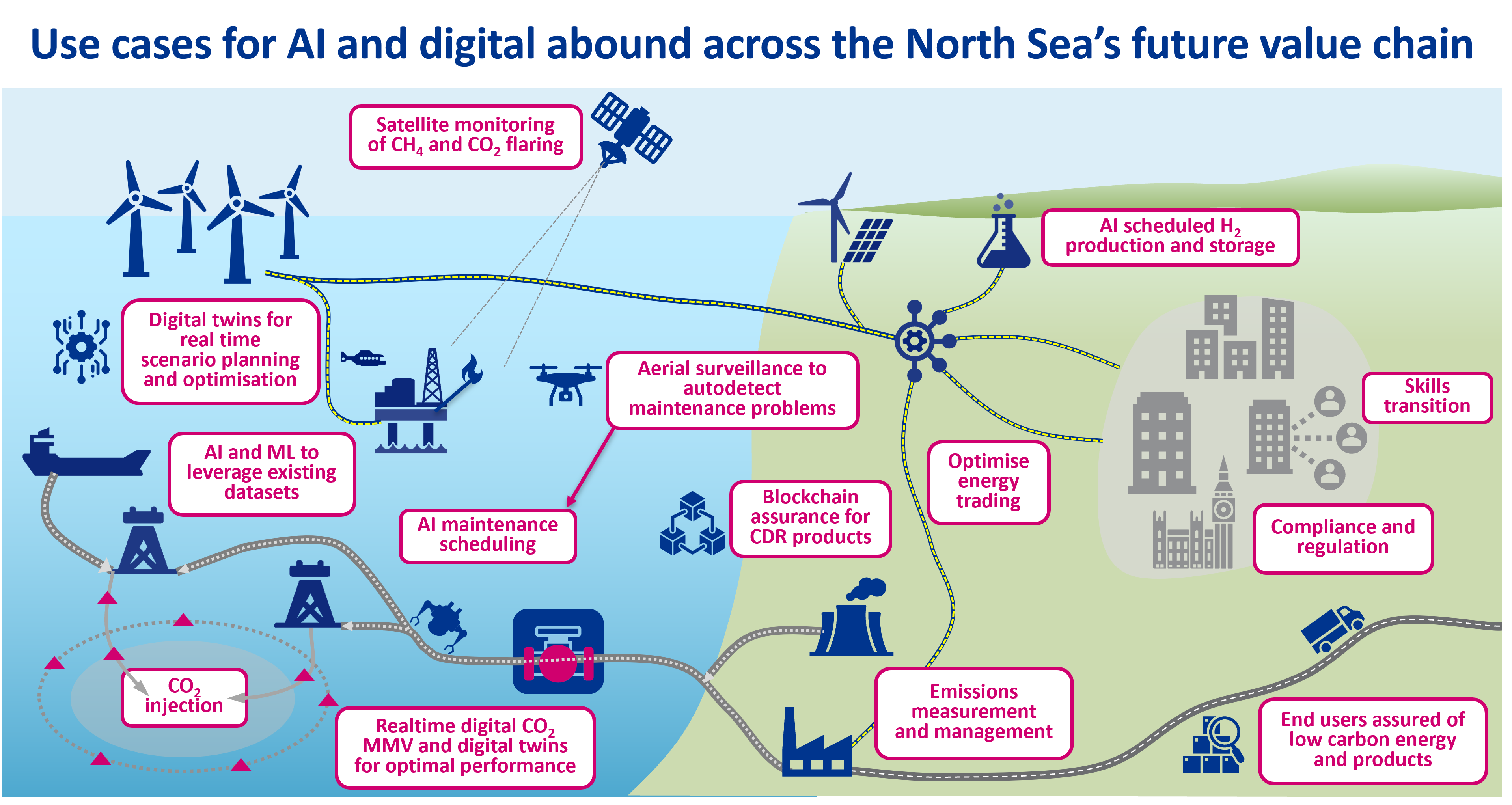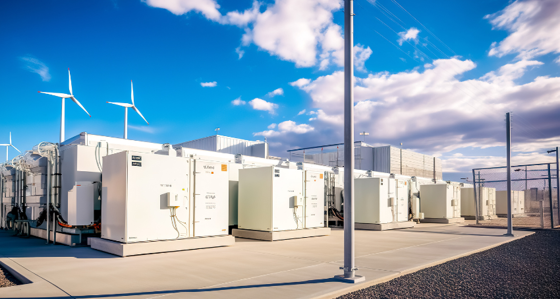
Unlocking the North Sea’s future potential with digital and AI
6 min read 21 August 2025
The North Sea has long been an energy powerhouse for the UK and Europe, but as the world moves to net zero, its role must evolve. We explore how AI and digital technologies could hold the keys to securing a cleaner, more resilient future for North Sea energy.
For more than 50 years, the North Sea has helped power homes and businesses in the UK and beyond. The region has contributed billions to the economy, created hundreds of thousands of jobs, and provided critical energy security through its vast oil and gas reserves.
Now, the North Sea faces a pivotal moment. While continuing to supply oil and gas, it must also transform to underpin the UK’s and other economies’ transition toward renewable, low-carbon energy.
|
A bold vision for the future of the North Sea How can the North Sea transform and decarbonise to remain a bastion of the UK’s energy landscape? Baringa and Offshore Energies UK (OEUK) explore how the region can evolve to become a leader in the energy transition, while preserving taxpayer revenues, jobs, and energy security. Learn more by downloading Baringa’s Future of the North Sea report. |
Turning energy heritage into net-zero leadership
However, this doesn’t mean transitioning away from oil and gas altogether. A successful path forward is one that prioritises responsible production of oil and gas alongside renewable energy development. It demands a holistic approach, where decarbonised oil and gas are integrated with new technologies, including offshore wind, carbon capture and storage (CCS), offshore hydrogen production and storage, and energy islands.
There is a huge opportunity for the North Sea to become a leader in the new, decarbonised energy landscape, securing a supply of low-cost, high-value energy for decades to come. By this we mean energy that is competitive and affordable, as well as secure, flexible, and sustainable.
However, achieving this will be an immense undertaking, requiring development of new infrastructure, supply chains, and technologies, as well as new commercial models and partnerships to secure and align investment.
At Baringa, we believe that artificial intelligence (AI) and digital technology can be central enablers and accelerators of this evolution. We have identified four key areas where large-scale deployment of AI and digital technology will support an effective transition to a low-carbon future for the North Sea.

By focusing on these four pillars, the North Sea can optimise existing oil and gas production, accelerate the development of low-carbon technologies, support local technology supply chains, and attract further investment into critical energy infrastructure and production improvements.
1. Enhancing operational efficiency
The future viability of North Sea energy will hinge on driving down production and operating costs, which are currently high compared to other producing regions. Use of AI and digital technologies can help to optimise costs and energy output, while supporting productivity improvements and skills development efforts.
|
Cost savings |
Efficiency improvements |
Productivity and skills gains |
| Cost reduction through predictive maintenance, with average savings of 25% (Bank of England) which amounts to £5.5bn in total savings for the UK energy industry alone | Use of AI and IoT technologies can cut unplanned downtime between 20-30% through predictive maintenance | Deploying (Gen)AI alongside human workers enhances and accelerates multiple tasks |
| Digital twins to optimise costs and energy output can achieve 25% reduction in LCOE for offshore wind | Digital twins enable optimised planning for complex renewable systems, increasing turbine revenue by 7% and efficiency by 20% | AI-powered learning and remote assist technology facilitate rapid upskilling and knowledge transfer |
| Advanced connectivity solutions to enhance real-time data utilisation and autonomous operations deliver cost savings of around 25% (Bank of England) | Using AI and digital twins with data on weather, turbine performance and grid capacity to enable near-real-time forecasting and capacity alignment | AI can bridge critical skills gaps by providing the workforce with task-specific support |
2. Optimising project delivery
Strategic deployment of digital technology and AI can optimise all phases of the project delivery cycle by enabling optimised planning, contracting, supplier managment and risk management and improving execution and handover. This is vitally important, given the reality that nearly all mega infrastructure projects suffer from cost and schedule overruns.

AI is already transforming PMO functions by strengthening scheduling, cost forecasting, procurement and contracting, risk management, and decision-making abilities. At Baringa, we see a growing number of energy and infrastructure clients embracing AI to enhance their project controls capabilities. These include tools that predict likely delays, identify high-risk activities, simulate new mitigation strategies, and generate new project schedules from scratch. Others are using AI-powered health checks and forensic schedule analysis to surface hidden activity dependencies and reveal deeper insights into the root causes of project delays.
Take GE Digital, who implemented an AI-driven project portfolio management (PPM) solution to manage its extensive portfolio of industrial IoT projects. The system utilises predictive analytics to forecast project timelines, resource requirements, and potential risks. Likewise, Siemens has introduced an AI-powered tool that analyses project budgets, resource costs, and financial risks to recommend cost-saving measures and prioritise projects based on potential ROI.
3. Increasing attractiveness for investment
AI and digital technology can drive down risks and costs while improving project performance, compliance, and confidence in financial fundamentals. This is crucial to ensuring that energy infrastructure projects in the North Sea attract maximum investment.
AI-powered scenario planning, predictive analysis, and performance simulations allow for more reliable and forecastable project performance – delivering the certainty needed to secure investor buy-in. Similarly, with enhanced risk modelling and maintenance strategies, underpinned by AI tools, organisations can extend asset lifespans and improve rates of return, ensuring cost-effective growth.
Additionally, AI and digital have an increasingly valuable role to play in optimising revenue through their integration into energy trading strategies. We are actively involved with clients on this through Baringa’s Energy Source platform, designed to help energy users build, manage, and report on Power Purchase Agreements (PPAs) and their wider energy demand portfolio.
Finally, with investors and lenders increasingly using ESG performance as a proxy for long-term risk mitigation, organisations that can transparently report on ESG progress stand to benefit from lower borrowing costs and better financing terms. Digital technology can be great helpers here, enabling data-driven due diligence, along with enhanced revenue and climate scenario testing.
Baringa recently supported a global mining company in implementing such a strategy, connecting diverse data sources to establish precise Scope 1, 2, and 3 emissions baselines. Our approach not only ensured regulatory compliance but positioned the company to access broader investment capital, including ESG-focused funds.
4. Powering a low-carbon future
As the UK charts its course towards net zero by 2050, AI and digital technology will be vital enablers of the North Sea's transformation into a decarbonised energy hub. These technologies have a crucial role to play in building a future, low-carbon energy system, with many potential applications across the value chain.

One such opportunity lies in creating a fully integrated, data-connected network that spans energy operations and their associated value chains. There is already a wealth of data to draw on, such as geological and operational information housed in NSTA and BGS databases. By using AI and machine learning capabilities to link these existing data sources with digital twin technologies, operators can ensure optimal hydrocarbon extraction and precise planning for CCS and other subsurface technologies.
Equally vital is establishing end-to-end carbon footprint transparency that provides users with full visibility into the environmental impact of their energy purchases and trades. Advanced digital tracking systems support regulatory compliance whilst optimising cost structures across the entire value chain, delivering both environmental and economic value to end users.
The North Sea’s next chapter is unfolding now
The North Sea has long been a backbone of the UK's energy strategy, and this unique heritage positions it to drive the energy transition forward. Decades of expertise, established supply chains, and skilled talent can be transformed and channelled into building a robust, low-carbon energy system.
By placing AI and digital technologies at the heart of this transformation, the North Sea can secure both a profitable and resilient future. The opportunity is there for the taking – but success also requires thoughtful action.
Without a clear strategy and comprehensive transformation, technology investments often fall short of delivering lasting impact. With research suggesting that more than 70% of digital transformation projects fail to deliver successful outcomes, organisations should be wary about rushing headlong into new AI and digital initiatives.
To make the most of the opportunity, organisations must ensure that technological change is backed up by complementary cultural and operational transformation. It means making sure there is a genuine need for AI and digital technology, defining a compelling vision for change, and bringing along people at all levels through education and upskilling.
The path ahead requires sustained commitment, and organisations that commit to deploying AI and digital technology with intent and purpose will be best positioned to lead in the new energy economy that is already taking shape.
Want to explore how AI and digital technologies can help you unlock long-term success in the North Sea by improving your operational efficiency and project delivery? Get in touch with Esther Diederen or Matthew Booth to discuss how Baringa can be a part of your journey.
Our Experts

Related Insights

From Pilots to Portfolios: Scaling the Rollout of Utility Microgrids
Across the U.S., utilities are under pressure to deliver reliable, affordable energy in the face of rising risks and shifting policies. Download our research to see how scaling microgrids can help meet that challenge.
Read more
Safeguarding critical energy infrastructure against converging cyber and physical threats
UK energy utilities strengthen their resilience against emerging cyber-physical threats by developing a holistic security methodology that bridges digital and physical domains.
Read more
Vom Commodity-Anbieter zum intelligenten Dienstleister: Wie Energieversorger mit KI den Kundenservice transformieren
Die Rolle von Künstlicher Intelligenz im Wandel der Energiebranche
Read more
Bending the technology cost curve: How energy companies can optimise IT spend to power innovation, value and growth
The shift to cloud computing and as-a-service models is transforming how energy businesses consume and pay for IT resources, bringing both opportunities and challenges.
Read moreIs digital and AI delivering what your business needs?
Digital and AI can solve your toughest challenges and elevate your business performance. But success isn’t always straightforward. Where can you unlock opportunity? And what does it take to set the foundation for lasting success?